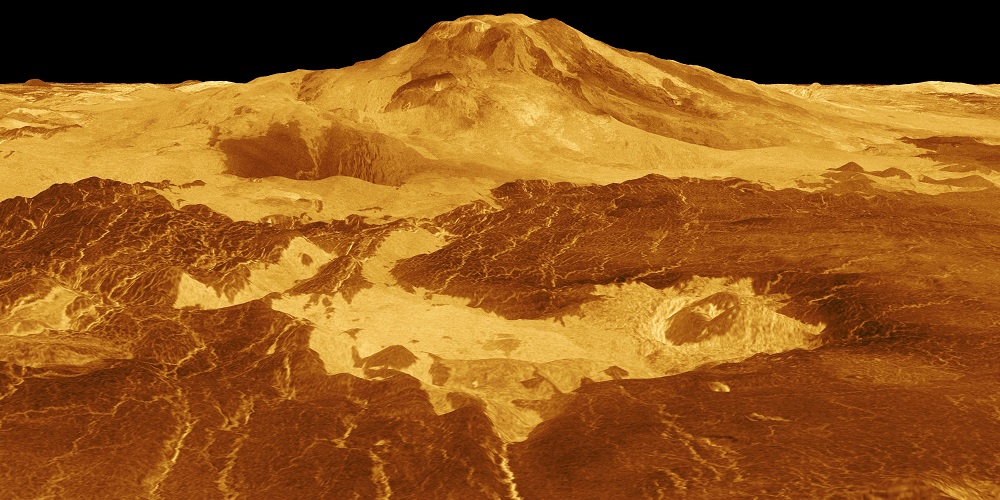User rating: 5 / 5
Scientists have seen direct evidence of active volcanism on Earth’s twin for the first time, paving the way for investigation by the agency’s Veritas mission. For the first time, direct geological evidence of recent volcanic activity has been observed on the surface of Venus.
Scientists made this discovery after studying old radar images of Venus taken more than thirty years ago in the 1990s by NASA’s Magellan mission. The images showed a volcanic vent that had changed shape and significantly increased in size in less than a year.
Scientists study active volcanoes to understand how a planet’s interior may shape its crust, direct its evolution, and influence its habitability. One of NASA’s new missions to Venus will do just that. VERITAS — short for Venus Emissivity, Radio Science, InSAR, Topography, and Spectroscopy — is being led by the Jet Propulsion Laboratory in Southern California and will be launched within ten years. The probe will study Venus from surface to core to understand how a rocky planet, about the same size as Earth, took a completely different path and evolved into a world covered in volcanic plains and distorted terrain, hidden under a thick, hot and toxic atmosphere. .
“NASA’s selection of the VERITAS mission to search Magellan’s data on recent volcanic activity inspired me,” said Robert Herrick, a research professor at the University of Alaska Fairbanks and member of the Veritas science team, who led the search of the archival data. “I wasn’t really expecting success, but after about 200 hours of manually comparing images from different Magellan orbits, I saw two images of the same area eight months apart that showed amazing geological changes due to the eruption.”
Volcano modeling
The geological changes Herrick found occurred at Atla Reggio, a vast highland region near Venus’ equator that is home to two of the largest volcanoes on the planet, Oza Mons and Maat Mons. The area has long been thought to be volcanically active, but there has been no direct evidence of recent activity. By studying Magellan’s radar images, Herrick discovered a volcanic vent in Ma’at Mons that changed dramatically between February and October 1991.
In the February image, the opening appeared almost circular, covering less than 2.2 square kilometres. It had steep walls on the inside and evidence of lava runoff on the outside, which are indicative of activity. In radar images taken eight months later, the same hole was twice as large and distorted. It also seemed filled to the brim with a lake of lava.
But because the two observations were made from opposite angles, they had different perspectives, making comparing them difficult. The low resolution of three decades of data made the task more complicated.
Herrick collaborated with JPL’s Scott Hensley, a project scientist at Veritas who, like Magellan, specializes in analyzing radar data. The two researchers made computer models of the vent in different configurations to test different scenarios of geological events, such as landslides. From these models, they concluded that only a volcanic eruption could cause the change.
“Only a few simulations match the images, and the most likely scenario is that volcanic activity occurred on the surface of Venus during the Magellan mission,” Hensley said. “While this is just a data point for an entire planet, it confirms the presence of recent geological activity.”
Scientists compare the size of the pyroclastic flow generated by Maat Mons’ activity to the 2018 Kilauea eruption on the Big Island of Hawaii.
Magellan’s legacy
Herrick, Hensley, and the rest of the VERITAS team are excited to see how the mission’s array of advanced science instruments and high-resolution data will complement Magellan’s remarkable wealth of radar images that have changed humanity’s understanding of Venus. “Venus is a mysterious world, and Magellan presented many possibilities,” said Jennifer Witten, deputy principal investigator at Tulane University in New Orleans. “Now that we know for sure that the planet experienced a volcanic eruption only 30 years ago, this is a small preview of the amazing discoveries Veritas will make.”
VERITAS will use advanced synthetic aperture radar to create 3-D global maps and a near-infrared spectrometer to see what the surface is made of. The spacecraft will also measure the planet’s gravitational field to determine the structure of Venus’ interior. Together, the instruments will provide clues about the planet’s past and current geological processes.
And while studying Magellan’s data was already cumbersome—in the 1990s, Herrick said, people relied on boxes of Venus data disks collected by NASA and delivered by mail—Veritas data will be available online to the scientific community. This will enable researchers to apply advanced techniques, such as machine learning, to analyze the planet and uncover its deepest secrets.
These studies will be complemented by EnVision, a European Space Agency (ESA) mission to Venus that will launch in the early 2030s. The spacecraft will carry its own Synthetic Aperture Radar (called VenSAR), which is being developed at JPL, as well as an instrument Spectrum similar to that found in Veritas. Hensley and Herrick are key members of the VenSAR science team.
source: NASA

“Thinker. Coffeeaholic. Award-winning gamer. Web trailblazer. Pop culture scholar. Beer guru. Food specialist.”







More Stories
Comet Tsuchinshan-Atlas is ready to shine this fall
Sonos isn’t bringing back its old app after all
Indiana Jones and the Great Circle is coming to PS5 in spring 2025